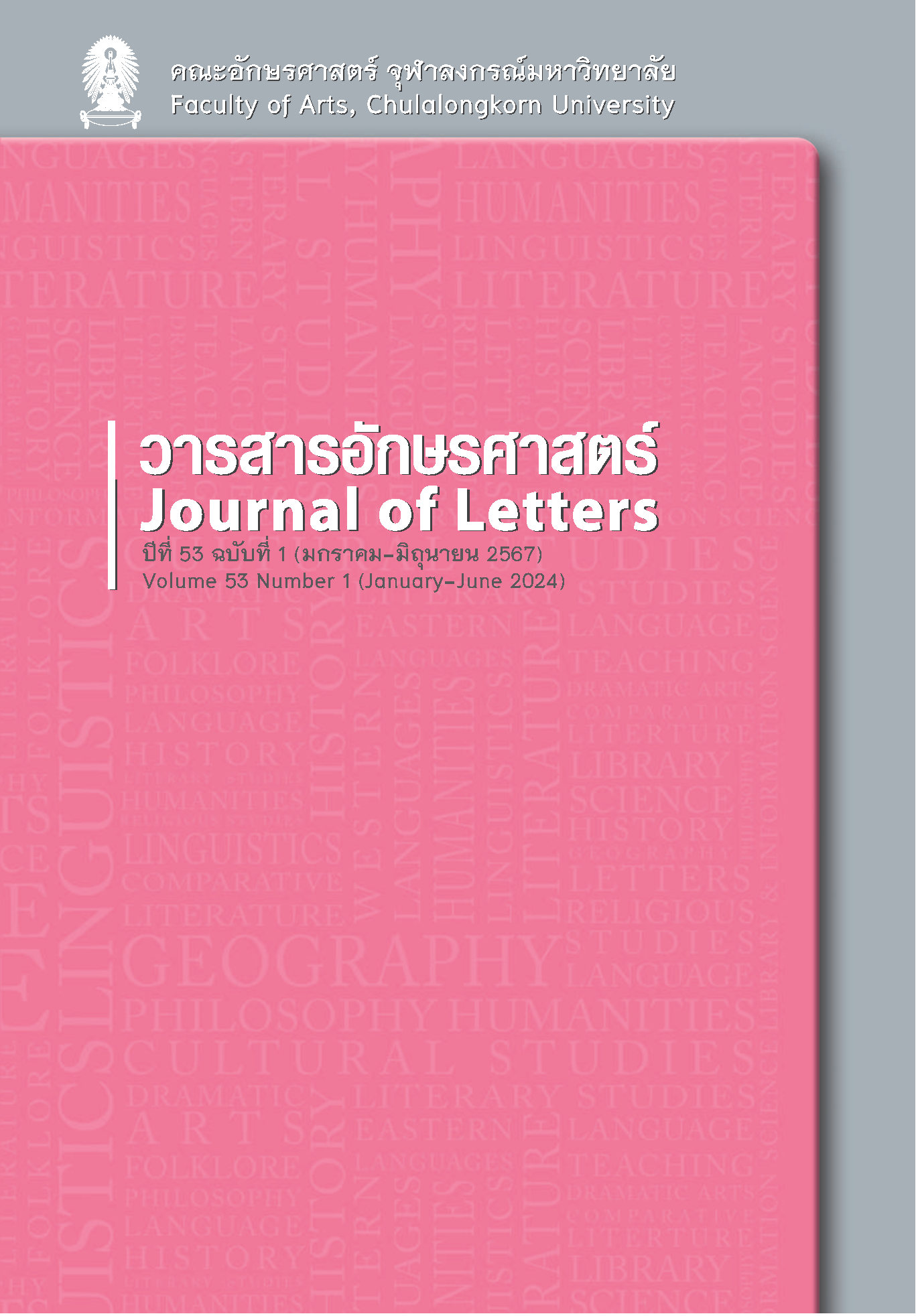Translation of Cases of Greek Nouns into Chinese:
A Case Study from The Gospel of Matthew 5-7
Keywords:
Biblical Greek, Chinese, Case, Chinese Translation, Religious Text TranslationAbstract
This article aims to study the translation of Cases of Greek nouns into Chinese. Using a case study from Matthew 5-7 in Chinese translation of the Bible (Chinese Union Bible), the research found that the Chinese translation of the Bible have four main forms of translation for Greek noun’s cases: Direct translation, Partial translation, Rearranged translation and Omitted. For the comparing the forms of translation with the earlier Chinese translations of other religious texts, it was found that Bible translations have more open and diverse forms and standards. It is not relying on the original text beyond necessity but has changed the presentation style according to the era.
References
ภาษาไทย
Ezra Mothanaprakoon เอษรา โมทนาพระคุณ. (2005). Tham khwam khaochai phasa Greek ทำความเข้าใจภาษากรีก [Understanding Greek]. Kanok Bannasan.
Kanokporn Numtong กนกพร นุ่มทอง. (2011). Tamra kanplae phasa Thai pen phasa Chin ตำราการแปลภาษาไทยเป็นภาษาจีน [Thai-Chinese Translation Textbook] (2nd ed.). Confucious Institute of Kasetsart University.
Pranote Buskornreungrat & Surasak Kitiruangsaeng ประณต บุษกรเรืองรัตน์ และสุรศักดิ์ กิติเรืองแสง. (2007). Waiyakorn phasa Greek khong phanthasanya mai ไวยากรณ์ภาษากรีกของพันธสัญญาใหม่ [New Testament Greek grammar]. Bangkok Institute of Theology an affiliate of Christian University.
Saman Kaewruang & Sanit Sinak สมาน แก้วเรือง และสานิตย์ สีนาค. (2021). Nathi khong karok nai phasa Hindi lae khwammai nai phasa Thai หน้าที่ของการกในภาษาฮินดี และความหมายในภาษาไทย [The function of Cases in Hindi and their meaning in Thai]. Warasarn puttha sangkhom wittaya paritat วารสารพุทธสังคมวิทยาปริทรรศน์ [Journal of Buddhistic Sociology], 6(1), 133-147
Sinchai Chaojaroenrat ศิลป์ชัย เชาว์เจริญรัตน์. (2007). Samruat Phrakhamphi สำรวจพระคัมภีร์ [Explore the Bible]. Chruch Education and Development.
Thailand Bible Society สมาคมพระคริสตธรรมไทย. (2011). Phrakhamphi Chabap mattrathan 2011 พระคัมภีร์ฉบับมาตรฐาน 2011 [Thai Standard Bible 2011]. YouVersion. Retrived July 7, 2022, from https://www.bible.com/th/versions/174-THSV11-
ภาษาต่างประเทศ
Chinese Bible 中文聖經:和合本. (n.d.). Heheben (1919) 和合本 (1919) [Chinese Union Version (1919)]. Bible Bento. Retrieved July 16, 2022, from https://biblebento.com/cuvs/cuvs.html
Croy, N. C. (1999). A primer of Biblical Greek. William B. Eerdmans Publishing.
Li, B. H. 李博寒. (2019). Hanyi Fojing dui Fanyu Conggedefanyi --- yi he weili 汉译佛经对梵语从格的翻译———以《无量寿经》和《维摩诘经》为例 [The translation of Sanskrit Ablative Case in the Chinese translations of Buddhist scriptures: A case of “The Larger Sukhāvatīvyūha Sūtra” and “VimalakīrtiNirdeśa Sūtra”]. Zhejiang Shifan Xueyuan daxue xuebao 浙江师范大学学报 [Journal of Zhejiang Normal University], 44, 27-35.
Liu, J. 刘俊. (2008). Shengjing Fanyishi 圣经翻译史 [History of Bible translating]. Jilinsheng jiaoyu xueyuan xuebao吉林省教育学院学报 [Journal of College of Education of Jilin] 24, 78-79.
Scrivener, F. H. A. (1894). Textus Receptus Greek New Teastament. Textus Receptus Bibles. Retrieved July 7, 2022, from https://textusreceptusbibles.com/Scrivener
You, C. R. 尤垂然. (2019). jianzhi hefanyichelue (xia)《和合本》 简史和翻译策略(下)[A brief history and translation of “Chinese Union Version” (Part 2)]. Christian Weekly. Retrieved July 12, 2023, From http://www.christianweekly.net/2019/ta2037780.htm
Downloads
Published
How to Cite
Issue
Section
License

This work is licensed under a Creative Commons Attribution-NonCommercial-NoDerivatives 4.0 International License.
Copyright and plagiarism
Authors are responsible for obtaining permission to use copyrighted materials from copyright owners. Authors are responsible for observing requisite copyright law when quoting or reproducing copyrighted materials. Quotations and reproductions of content from other published sources must be accompanied by a reference and all sources should be clearly listed in the references section. Quotations and reproductions of content from external sources without due attribution could be considered a severe infringement of academic conduct and may constitute a legal offence under the Copyright Act of B.E. 2537. Any legal ramifications arising from the infringement of copyright regulations would be the sole responsibility of the author(s).



